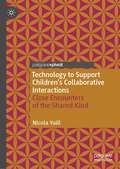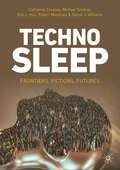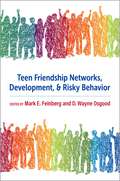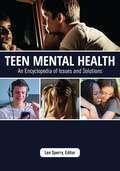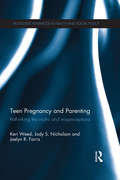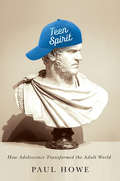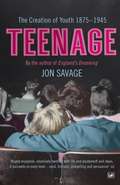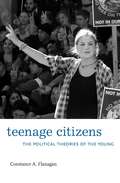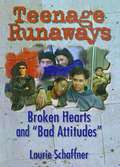- Table View
- List View
Technology to Support Children's Collaborative Interactions: Close Encounters of the Shared Kind
by Nicola YuillThis book explores how technology can foster interaction between children and their peers, teachers and other adults. It presents the Co-EnACT framework to explain how technology can support children to collaborate, so helping them to learn and engage enjoyably with the world, in both work and play. The focus is on children, rather than young people, but the principles of supporting interaction apply throughout all life stages. Chapters on classrooms and on autism explain principles behind using technology in ways that support, rather than obstruct, social interaction in diverse populations. Collaborative interaction involves both verbal and non-verbal behaviour and this book presents evidence from closely analysing children’s behaviour in natural settings. Examples from cutting-edge technology illustrate principles applicable to more widely-available technology. The book will be of interest to psychologists, educators, researchers in Human–Computer Interaction (HCI), particularly those designing with children in mind, and practitioners working with children who want to deepen their understanding of using technology for collaboration.
Technosleep: Frontiers, Fictions, Futures
by Catherine Coveney Michael Greaney Eric L. Hsu Robert Meadows Simon J. WilliamsThis book draws on a variety of substantive examples from science, technology, medicine, literature, and popular culture to highlight how a new technoscientifically mediated and modified phase and form of technosleep is now in the making – in the global north at least; and to discuss the consequences for our relationships to sleep, the values we accord sleep and the very nature and normativities of sleep itself.The authors discuss how technosleep, at its simplest denotes the ‘coming together’ or ‘entanglements’ of sleep and technology and sensitizes us to various shifts in sleep–technology relations through culture, time and place. In doing so, it pays close attention to the salience and significance of these trends and transformations to date in everyday/night life, their implications for sleep inequalities and the related issues of sleep and social justice they suggest.
Ted Bundy and The Unsolved Murder Epidemic: The Dark Figure of Crime
by Matt DeLisiThis book revisits the life and crimes of Ted Bundy. It seeks to reconcile the contradictions and controversies about his life that underscore the broader US unsolved murder problem, one that is estimated at between 250,000 to 350,000 open, unresolved, or cold cases. The incidence of crime is far greater than is captured by official statistics; most offenses are never detected, a concept known as the dark figure of crime which is explored here. Drawing on 25 years of practitioner, research, and consultant experiences with the most violent criminals, this book offers solutions toward clearing the current backlog of unsolved murders in the United States many of which were never reported and disproportionately perpetrated by offenders like Bundy. This compelling book speaks to students, academics and readers interested in true crime, serial murder, homicide and criminal justice.
Teen Anxiety: A CBT and ACT Activity Resource Book for Helping Anxious Adolescents
by Raychelle Cassada Cassada LohmannTeen Anxiety is a practical manual to help teens cope with and deal with anxiety. Based on Cognitive Behavioural Therapy (CBT) and Acceptance Commitment Therapy (ACT), it includes full guidance for professionals as well as 60 activities to use with young people. Scaling questions for assessment and graphs to track progress are also included.
Teen Friendship Networks, Development, and Risky Behavior
by Mark E. Feinberg and D. Wayne OsgoodThe PROSPER study is the premier study of adolescent peer networks in the world, with a scope of over 12,000 youth in 28 school districts, and with 8 annual waves of data collection covering grades 6-12. Research output from the PROSPER study has provided extensive new insights in the areas of adolescent development, risky behaviors, and social networks. Through the lens of the PROSPER study, Teen Friendship Networks, Development, and Risky Behavior describes the many ways that adolescent friendship networks channel and facilitate the spread of adolescent substance use, delinquent behaviors, mental health problems, educational success, romantic relationships, and future development. Introductory chapters explain the theories of adolescent development and the elements of peer network science. The chapters of the main part of the book each focus on a domain of adolescent behavior, providing background on the topic and highlighting the contribution of the PROSPER study to understanding the way teen friendships operate to promote initiation or diffusion of the behavior or attribute. With coverage of major themes such as the ways that teens select friends based on particular characteristics or similarity between them, and the ways that friends, once selected, influence each other, as well as discussion of how friendship and network patterns are linked to the uptake and spread of positive prevention messages, Teen Friendship Networks, Development, and Risky Behavior will appeal to researchers and students across several fields.
Teen Friendship Networks, Development, and Risky Behavior
The PROSPER study is the premier study of adolescent peer networks in the world, with a scope of over 12,000 youth in 28 school districts, and with 8 annual waves of data collection covering grades 6-12. Research output from the PROSPER study has provided extensive new insights in the areas of adolescent development, risky behaviors, and social networks. Through the lens of the PROSPER study, Teen Friendship Networks, Development, and Risky Behavior describes the many ways that adolescent friendship networks channel and facilitate the spread of adolescent substance use, delinquent behaviors, mental health problems, educational success, romantic relationships, and future development. Introductory chapters explain the theories of adolescent development and the elements of peer network science. The chapters of the main part of the book each focus on a domain of adolescent behavior, providing background on the topic and highlighting the contribution of the PROSPER study to understanding the way teen friendships operate to promote initiation or diffusion of the behavior or attribute. With coverage of major themes such as the ways that teens select friends based on particular characteristics or similarity between them, and the ways that friends, once selected, influence each other, as well as discussion of how friendship and network patterns are linked to the uptake and spread of positive prevention messages, Teen Friendship Networks, Development, and Risky Behavior will appeal to researchers and students across several fields.
Teen Mental Health: An Encyclopedia of Issues and Solutions
by Len SperryThis encyclopedia provides a concise introduction to the mental health topics of greatest concern to adolescents. It offers young readers the information they need to better understand mental disorders and the importance of psychological well-being.Addressing mental illness and prioritizing psychological well-being are important at any age, but the teen years present unique challenges. Hormonal changes, peer pressure, and the demands of school and a busy social life combined with many other factors put adolescents at high risk for mental health problems. Certain disorders, such as depression and anxiety, are particularly prevalent in this age group, as are risky behaviors like substance abuse, self-harm, and distracted driving. Today's teens also face uniquely modern threats to their psychological well-being, such as Internet addiction and social media–induced fear of missing out (FOMO). Yet there are also ample opportunities for adolescents to strengthen their mental health and resiliency through such practices as meditation, activism, and youth leadership.Teen Mental Health: An Encyclopedia of Issues and Solutions is a ready-reference guide to the mental health topics that most affect the lives of American teens in the 21st century. Entries are accessibly written and feature extensive cross-referencing and helpful further reading lists. This volume also offers a collection of recommended resources, including a number of hotlines for teens in crisis.
Teen Mental Health: An Encyclopedia of Issues and Solutions
by Len SperryThis encyclopedia provides a concise introduction to the mental health topics of greatest concern to adolescents. It offers young readers the information they need to better understand mental disorders and the importance of psychological well-being.Addressing mental illness and prioritizing psychological well-being are important at any age, but the teen years present unique challenges. Hormonal changes, peer pressure, and the demands of school and a busy social life combined with many other factors put adolescents at high risk for mental health problems. Certain disorders, such as depression and anxiety, are particularly prevalent in this age group, as are risky behaviors like substance abuse, self-harm, and distracted driving. Today's teens also face uniquely modern threats to their psychological well-being, such as Internet addiction and social media–induced fear of missing out (FOMO). Yet there are also ample opportunities for adolescents to strengthen their mental health and resiliency through such practices as meditation, activism, and youth leadership.Teen Mental Health: An Encyclopedia of Issues and Solutions is a ready-reference guide to the mental health topics that most affect the lives of American teens in the 21st century. Entries are accessibly written and feature extensive cross-referencing and helpful further reading lists. This volume also offers a collection of recommended resources, including a number of hotlines for teens in crisis.
Teen Mental Health in an Online World: Supporting Young People around their Use of Social Media, Apps, Gaming, Texting and the Rest
by Victoria Betton James WoollardThis essential book shows practitioners how they can engage with teens' online lives to support their mental health. Drawing on interviews with young people it discusses how adults can have open and inquiring conversations with teens about both the positive and negative aspects of their use of online spaces.For most young people there is no longer a barrier between their 'real' and 'online' lives. This book reviews the latest research around this topic to investigate how those working with teenagers can use their insights into digital technologies to promote wellbeing in young people. It draws extensively on interviews with young people aged 12-16 throughout, who share their views about social media and reveal their online habits. Chapters delve into how teens harness online spaces such as YouTube, Instagram and gaming platforms for creative expression and participation in public life to improve their mental health and wellbeing. It also provides a framework for practitioners to start conversations with teens to help them develop resilience in respect of their internet use. The book also explores key risks such as bullying and online hate, social currency and the quest for 'likes', sexting, and online addiction.This is essential reading for teachers, school counsellors, social workers, and CAMHS professionals (from psychiatrists to mental health nurses) - in short, any practitioner working with teenagers around mental health.
Teen Mental Health in an Online World: Supporting Young People around their Use of Social Media, Apps, Gaming, Texting and the Rest
by Victoria Betton James WoollardThis essential book shows practitioners how they can engage with teens' online lives to support their mental health. Drawing on interviews with young people it discusses how adults can have open and inquiring conversations with teens about both the positive and negative aspects of their use of online spaces.For most young people there is no longer a barrier between their 'real' and 'online' lives. This book reviews the latest research around this topic to investigate how those working with teenagers can use their insights into digital technologies to promote wellbeing in young people. It draws extensively on interviews with young people aged 12-16 throughout, who share their views about social media and reveal their online habits. Chapters delve into how teens harness online spaces such as YouTube, Instagram and gaming platforms for creative expression and participation in public life to improve their mental health and wellbeing. It also provides a framework for practitioners to start conversations with teens to help them develop resilience in respect of their internet use. The book also explores key risks such as bullying and online hate, social currency and the quest for 'likes', sexting, and online addiction.This is essential reading for teachers, school counsellors, social workers, and CAMHS professionals (from psychiatrists to mental health nurses) - in short, any practitioner working with teenagers around mental health.
Teen Pregnancy and Parenting: Rethinking the Myths and Misperceptions
by Keri Weed Jody S Nicholson Jaelyn R. FarrisWhether glamorised or stigmatised, teenage parenthood is all too often used to stand for a host of social problems, and empirical research results ignored. Identifying core controversies surrounding teen pregnancy and parenting, this book resolves misperceptions using findings from large-scale, longitudinal, and qualitative research studies from the US and other Western countries. Summarising the evidence and integrating it with a systems perspective, the authors explore ten prevalent myths about teenage parents, including: Teen pregnancy is associated with other behavior problems. Children of teen parents will experience cognitive delay, adjustment problems, and will themselves become teen parents. Better outcomes are achieved when teen mothers live with their own mothers. Teen pregnancy costs tax payers lots of money. Abstinence education is the best way to prevent teen pregnancy. Teen Pregnancy and Parenting ends by highlighting the prevention and intervention implications for families, practitioners, and policymakers. It will be of interest to academics and advanced students from a range of disciplines and professions including psychology, public policy, nursing, social work and sociology.
Teen Pregnancy and Parenting: Rethinking the Myths and Misperceptions
by Keri Weed Jody S Nicholson Jaelyn R. FarrisWhether glamorised or stigmatised, teenage parenthood is all too often used to stand for a host of social problems, and empirical research results ignored. Identifying core controversies surrounding teen pregnancy and parenting, this book resolves misperceptions using findings from large-scale, longitudinal, and qualitative research studies from the US and other Western countries. Summarising the evidence and integrating it with a systems perspective, the authors explore ten prevalent myths about teenage parents, including: Teen pregnancy is associated with other behavior problems. Children of teen parents will experience cognitive delay, adjustment problems, and will themselves become teen parents. Better outcomes are achieved when teen mothers live with their own mothers. Teen pregnancy costs tax payers lots of money. Abstinence education is the best way to prevent teen pregnancy. Teen Pregnancy and Parenting ends by highlighting the prevention and intervention implications for families, practitioners, and policymakers. It will be of interest to academics and advanced students from a range of disciplines and professions including psychology, public policy, nursing, social work and sociology.
Teen Spirit: How Adolescence Transformed the Adult World
by Paul HoweTeen Spirit offers a novel and provocative perspective on how we came to be living in an age of political immaturity and social turmoil. Award-winning author Paul Howe argues it's because a teenage mentality has slowly gripped the adult world.Howe contends that many features of how we live today—some regrettable, others beneficial—can be traced to the emergence of a more defined adolescent stage of life in the early twentieth century, when young people started spending their formative, developmental years with peers, particularly in formal school settings. He shows how adolescent qualities have slowly seeped upward, where they have gradually reshaped the norms and habits of adulthood. The effects over the long haul, Howe contends, have been profound, in both the private realm and in the public arena of political, economic, and social interaction. Our teenage traits remain part of us as we move into adulthood, so much so that some now need instruction manuals for adulting.Teen Spirit challenges our assumptions about the boundaries between adolescence and adulthood. Yet despite a cultural system that seems to be built on the ethos of Generation Me, it's not all bad. In fact, there has been an equally impressive rise in creativity, diversity, and tolerance within society: all traits stemming from core components of the adolescent character. Howe's bold and suggestive approach to analyzing the teen in all of us helps make sense of the impulsivity driving society and encourages us to think anew about civic reengagement.
Teen Stress: Your Questions Answered (Q&A Health Guides)
by Nicole Neda Zamanzadeh Tamara D. AfifiLife can be stressful, especially for teens, and this stress can have negative impacts on both physical and psychological health. This book answers readers' questions about the causes and consequences of stress and how it can be prevented and managed.Overscheduling, the pressure to get into a good college, bullying, body image, conflicts with friends, and social media are just a few of the many sources of stress for today's teens. And, while teens may face just as many, if not more, stressors than adults, they are less likely to have the coping mechanisms and stress management tools needed to effectively combat the stress they feel. Part of Greenwood's Q&A Health Guides series, Teen Stress: Your Questions Answered follows a reader-friendly question-and-answer format that anticipates readers' needs and concerns. Prevalent myths and misconceptions are identified and dispelled, and a collection of case studies illustrates key concepts and issues through relatable stories and insightful recommendations. Each book in the series also includes a section on health literacy, equipping teens and young adults with practical tools and strategies for finding, evaluating, and using credible sources of health information both on and off the internet—important skills that contribute to a lifetime of healthy decision-making.
Teen Stress: Your Questions Answered (Q&A Health Guides)
by Nicole Neda Zamanzadeh Tamara D. AfifiLife can be stressful, especially for teens, and this stress can have negative impacts on both physical and psychological health. This book answers readers' questions about the causes and consequences of stress and how it can be prevented and managed.Overscheduling, the pressure to get into a good college, bullying, body image, conflicts with friends, and social media are just a few of the many sources of stress for today's teens. And, while teens may face just as many, if not more, stressors than adults, they are less likely to have the coping mechanisms and stress management tools needed to effectively combat the stress they feel. Part of Greenwood's Q&A Health Guides series, Teen Stress: Your Questions Answered follows a reader-friendly question-and-answer format that anticipates readers' needs and concerns. Prevalent myths and misconceptions are identified and dispelled, and a collection of case studies illustrates key concepts and issues through relatable stories and insightful recommendations. Each book in the series also includes a section on health literacy, equipping teens and young adults with practical tools and strategies for finding, evaluating, and using credible sources of health information both on and off the internet—important skills that contribute to a lifetime of healthy decision-making.
The Teen Trauma Journal: Understanding the Past and Embracing Tomorrow!
by Laura StokesThis therapeutic journal provides you with the tools and coping strategies you need to better look after yourself. Covering topics such as attachment, thinking styles, self-esteem and new relationships, it looks at how early relationships and trauma may have impacted you, and supports you in planning for your future. Authored by experienced Consultant Clinical Psychologist Laura Stokes, this journal will be a source of support and guidance you as you navigate life's ups and downs.
Teenage: The Creation of Youth 1875-1945 (PDF)
by Jon Savage* The inspiration behind the film TEENAGE, narrated by Ben Whishaw and Jena Malone * This is a history never described before - the century and a half of ferment, folly and angst that created a separate Teen Age in Europe and America. We roam London, New York, Paris and Berlin with hooligans and Apaches; explore free love with Rupert Brooke and eternal youth with Peter Pan; we meet flappers and zootsuiters and the Bright Young Things, the unemployed and the Lost Generation. Meanwhile the book rings with music, from Ragtime to Swing, and the stories come fast and furious, comic, poignant, painfully moving. In 1945, 'the teenager' arrived. This is the story of how we got to that moment.
Teenage Citizens: The Political Theories Of The Young
by Constance A. FlanaganToo young to vote or pay taxes, teenagers are off the radar of political scientists. Yet civic identities form during adolescence and are rooted in experiences as members of families, schools, and community organizations. Flanagan helps us understand how young people come to envisage civic engagement, and how their political identities take form.
Teenage Citizens: The Political Theories Of The Young
by Constance A. FlanaganToo young to vote or pay taxes, teenagers are off the radar of political scientists. Yet civic identities form during adolescence and are rooted in experiences as members of families, schools, and community organizations. Flanagan helps us understand how young people come to envisage civic engagement, and how their political identities take form.
Teenage Depression - A CBT Guide for Parents: Help your child beat their low mood
by Shirley Reynolds Monika ParkinsonDepression is one of the most common mental health problems and is estimated to affect around 15% of people at some point during their life. For many people depression is a life-long disorder which starts during the teenage years –around 10% of teenagers are estimated to have an episode of depression and many more experience persistent low mood. This accessible companion book to Am I Depressed and What Can I do About it? follows essentially the same structure and makes use of the same case studies, but looks at the issues from the parents’ point of view, and incorporates additional strategies for parents. From ‘what to look out for’, through what the evidence says about different forms of treatment, to family communication and relapse prevention. Each section includes troubleshooting boxes.
Teenage Pregnancy and Young Parenthood: Effective Policy and Practice (Adolescence and Society)
by Alison HadleyTeenage Pregnancy and Young Parenthood provides a comprehensive, unparalleled insight into the UK Government’s highly successful Teenage Pregnancy Strategy (TPS) for England which reduced the under-18 pregnancy rate by well over 50%, and considers how the lessons from this policy can be applied internationally. This important book captures and shares the lessons from the TPS for future governments and policy makers, and documents the details of implementing a long-term strategy with its innovative approach to policy issues. After providing the rationale for prioritising teenage pregnancy, the book demonstrates evidence for what is effective, both in helping young people avoid unplanned pregnancy and in improving outcomes for young parents. The TPS is analysed against the World Health Organisation’s key actions for effective scale-up of adolescent sexual and reproductive health programmes, to offer an important contribution to international understanding of this global public health challenge. Advocating a ‘whole systems’ multi-agency approach this book translates evidence into clear action, and combines theory and practice with illustrative case studies to demonstrate how to implement policy successfully. It is valuable reading for policy makers and practitioners dealing with young people’s health, as well as undergraduate and postgraduate students in the fields of psychology, health studies, social work, youth work, education, social policy, sociology and related disciplines.
Teenage Pregnancy and Young Parenthood: Effective Policy and Practice (Adolescence and Society)
by Alison HadleyTeenage Pregnancy and Young Parenthood provides a comprehensive, unparalleled insight into the UK Government’s highly successful Teenage Pregnancy Strategy (TPS) for England which reduced the under-18 pregnancy rate by well over 50%, and considers how the lessons from this policy can be applied internationally. This important book captures and shares the lessons from the TPS for future governments and policy makers, and documents the details of implementing a long-term strategy with its innovative approach to policy issues. After providing the rationale for prioritising teenage pregnancy, the book demonstrates evidence for what is effective, both in helping young people avoid unplanned pregnancy and in improving outcomes for young parents. The TPS is analysed against the World Health Organisation’s key actions for effective scale-up of adolescent sexual and reproductive health programmes, to offer an important contribution to international understanding of this global public health challenge. Advocating a ‘whole systems’ multi-agency approach this book translates evidence into clear action, and combines theory and practice with illustrative case studies to demonstrate how to implement policy successfully. It is valuable reading for policy makers and practitioners dealing with young people’s health, as well as undergraduate and postgraduate students in the fields of psychology, health studies, social work, youth work, education, social policy, sociology and related disciplines.
Teenage Runaways: Broken Hearts and "Bad Attitudes"
by Laurie SchaffnerTeenage Runaways: Broken Hearts and “Bad Attitudes” uncovers the perspectives of actual teenage runaways to help professionals, parents, and youths understand the widespread social problem of “last resort” behavior. You’ll learn the real reasons teenagers run away, and you’ll hear the anguished voices of the teenage runaways themselves, shattering the myth that only bad kids runaway.Teenage Runaways deflates popular misconceptions that runaways are incorrigible delinquents who want to leave home, that they make impulsive decisions to leave their families, and that they wish to never return. Reporting on a qualitative study of 26 runaways in a shelter in New England, this book reveals that many teenaged runaways leave home in search of safety and freedom from what they consider abusive treatment, whether physical, sexual, or emotional. In Teenage Runaways, you will discover valuable information about who these children are, why they are running away, and what you can do to help. Specifically, you will read about: why teenagers say they run away running away as “last resort behavior” what the experience of running away is like hope and desire for reconciliation with parents and family running away as a dynamic emotional experience for youths which reflects changes in their social bonds with peers, family, and adults in the educational, legal, and medical systems “emotional capital” from a heavily regulated authoritative environment Teenage Runaways provides you with a new understanding of teens in trouble to assist you in providing services to this needy and vulnerable population. First-hand accounts reveal the emotional motivations behind decisions to run away, such as 14 years-old Isabel who gives a painful account of what severe physical and sexual abuse feels like to an adolescent victim. Amy, also 14, tells her story of living with a mother who was extremely strict and betrayed her.
Teenage Runaways: Broken Hearts and "Bad Attitudes"
by Laurie SchaffnerTeenage Runaways: Broken Hearts and “Bad Attitudes” uncovers the perspectives of actual teenage runaways to help professionals, parents, and youths understand the widespread social problem of “last resort” behavior. You’ll learn the real reasons teenagers run away, and you’ll hear the anguished voices of the teenage runaways themselves, shattering the myth that only bad kids runaway.Teenage Runaways deflates popular misconceptions that runaways are incorrigible delinquents who want to leave home, that they make impulsive decisions to leave their families, and that they wish to never return. Reporting on a qualitative study of 26 runaways in a shelter in New England, this book reveals that many teenaged runaways leave home in search of safety and freedom from what they consider abusive treatment, whether physical, sexual, or emotional. In Teenage Runaways, you will discover valuable information about who these children are, why they are running away, and what you can do to help. Specifically, you will read about: why teenagers say they run away running away as “last resort behavior” what the experience of running away is like hope and desire for reconciliation with parents and family running away as a dynamic emotional experience for youths which reflects changes in their social bonds with peers, family, and adults in the educational, legal, and medical systems “emotional capital” from a heavily regulated authoritative environment Teenage Runaways provides you with a new understanding of teens in trouble to assist you in providing services to this needy and vulnerable population. First-hand accounts reveal the emotional motivations behind decisions to run away, such as 14 years-old Isabel who gives a painful account of what severe physical and sexual abuse feels like to an adolescent victim. Amy, also 14, tells her story of living with a mother who was extremely strict and betrayed her.
Teenage Sex and Pregnancy: Modern Myths, Unsexy Realities (Sex, Love, and Psychology)
by Mike A. MalesThis detailed, exhaustively documented account shows how and why just about everyone in today's teen pregnancy debate is wrong—often disastrously so.Teenage Sex and Pregnancy: Modern Myths, Unsexy Realities presents a unique view of its subject by analyzing the extensive myths and fears that surround discussion of teenage sex and pregnancy, including their relationship to popular culture, poverty, adult sexual behaviors, and anxieties toward the increasingly public roles of young women.Award-winning author Mike Males argues that today's discussions rely largely on falsehoods and the suppression of crucial realities. His work details a new view of popular culture as a largely beneficial feature of teens' lives and presents a carefully documented analysis demolishing destructive myths about the "new girl." Debunking popular arguments, he shows that the "teen sex" debate is mired in interest-group talking points that ignore difficult realities to advance politically attuned agendas. It's time, he writes, to modernize the discussion, recognizing that teens act in ways consistent with their interests, with the sexual behaviors of adults, and with the school and job opportunities afforded them.
